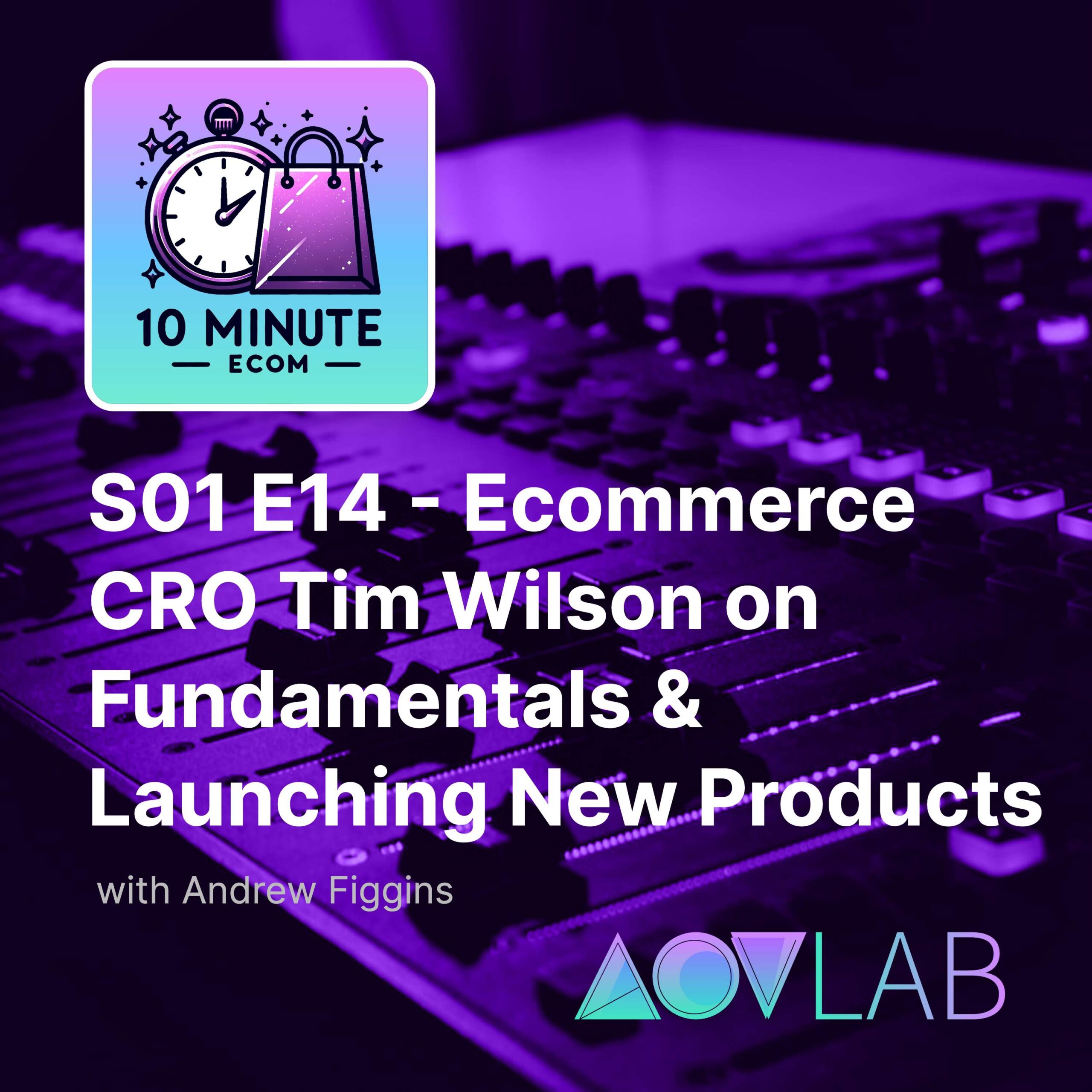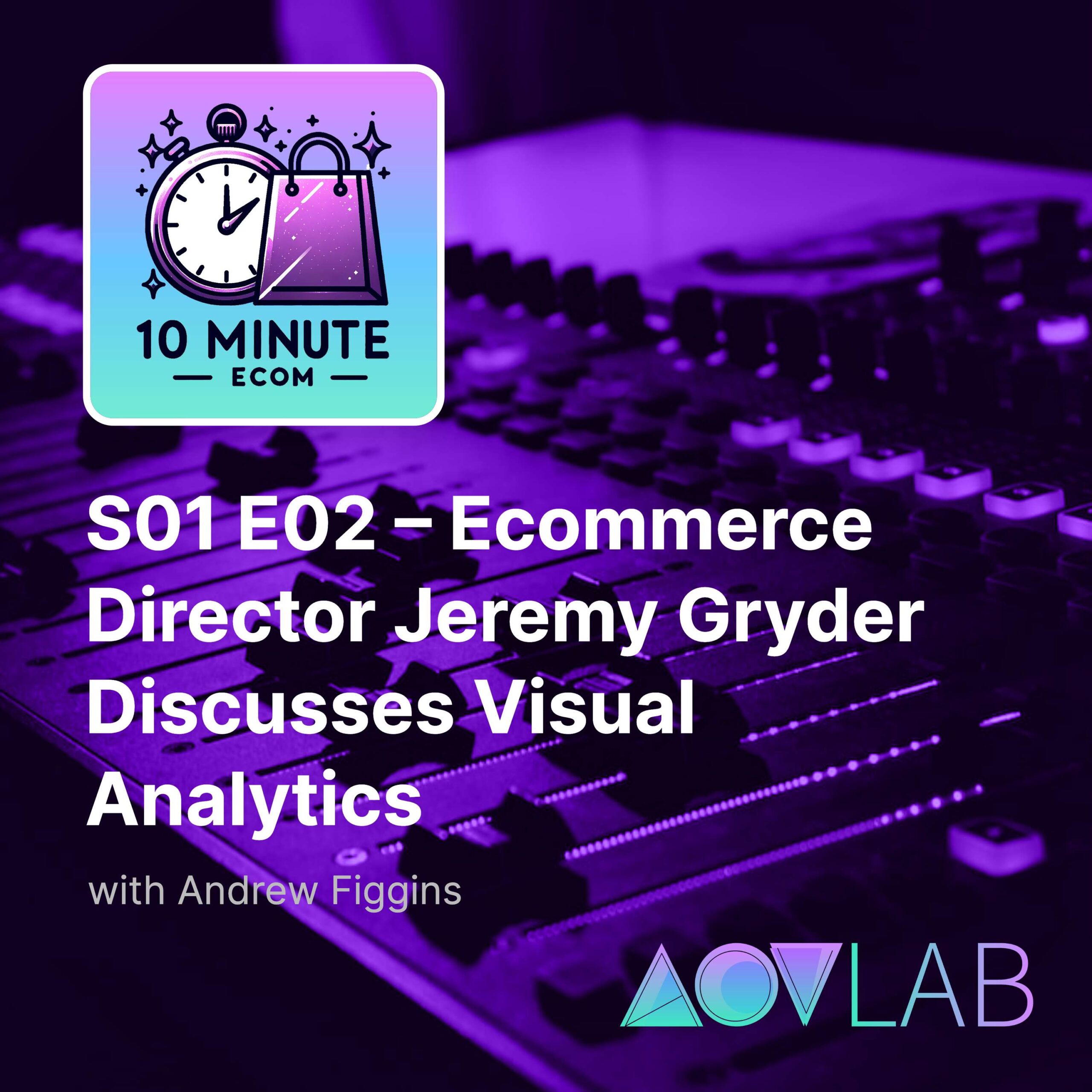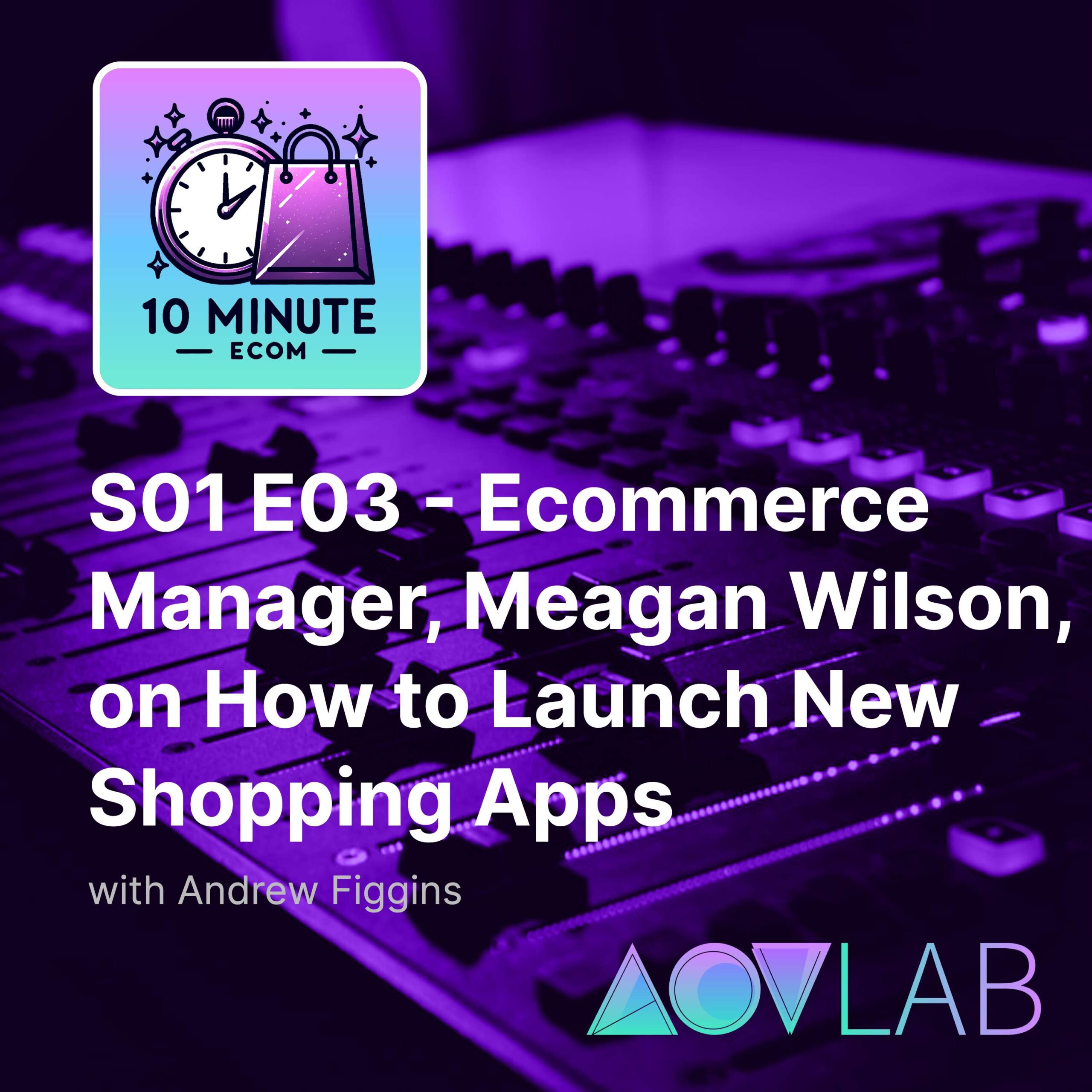Episode Transcript
[00:00:12] Speaker A: Ecommerce fans, and welcome to ten minute Ecom, an AOV Lab podcast. Every episode, we break down a new and different tactic that can help you improve your ecommerce KPIs key performance indicators. I'm your host, Andrew Figgins, and like most of you, I am an e commerce professional. You may know me as the founder of AOV Lab, the former vp of product innovation at Scrubs and beyond, or as the former director of e commerce technology at Rural King.
Today I'm excited to be talking to Ashley Anderson, an ecommerce colleague that is doing incredibly interesting work in e comm for a really cool brand called Rumple.
[00:00:49] Speaker B: Which if you haven't heard of, take.
[00:00:51] Speaker A: A moment and check out sometime today.
Anyway, Ashley, what did you come on the show today to share with your ecommerce colleagues?
[00:00:58] Speaker C: I am Ashley Anderson and I am the director of e commerce at Rumple, based out of Portland, Oregon. But I'm located in Texas, and today I'm going to cover one thing that I've seen work in ecommerce across multiple industries, conversion rate optimization, better known as CRO.
[00:01:16] Speaker A: Thank you, Ashley. After the ad, we'll get right into the chat. Today's episode of ten minute ecom is brought to you by shop AoV Lab. It is a brand new store with fun apparel and gear specifically for ecommerce professional just like you and me, we've got high quality embroidered and printed t shirts, hoodies, and hats that will spice up any zoom call or in person meeting with your team. If you lead a team, these products make for awesome gifts to celebrate hitting a conversion rate or average order value milestone. If you work in ecommerce, I think you'll not only find some humor in these products, but also a sense of.
[00:01:55] Speaker B: Pride for what you do every day.
[00:01:57] Speaker A: Again, the site is shop AOV Lab. Head over right now and browse while you listen. Unless you're driving. In that case, pull over. You've got to see and share these products one last time. The website is shop aov lablab.com.
And now back to the show.
[00:02:19] Speaker B: Thanks so much, Ashley, for joining the show today. I'm so excited that you're here. You have a wealth of experience in e commerce. It's a pleasure to be able to talk to you. Tell me a little bit about what aspect of CRO. I think CRO gets used quite a bit in our industry in e commerce. But which area specifically about CRO are you focused on and thinking about today?
[00:02:40] Speaker C: I think CRO circling back to what you first, and I think CRO gets used a lot. And I think it's a scary word because you feel like you need to have a full team dedicated and you need all of these tools and be able to analyze, but it's something that you can do really at any level, any industry. I worked at organizations that had an entire team dedicated to CRO, and we're hitting statistical significance every hour. And I've also worked at organizations where you have one person who, they're doing it irregularly and testing things based on what they're seeing and what we're seeing from a revenue and conversion rate and where those opportunities are. So I think that's one thing that CRO in general just, I think it's such a scary word, but it doesn't have to be scary.
From a smaller business perspective. There are tools out there such as Nosto that you can run, you can implement on your website, integrate with Shopify and other tools in that realm, and you just add that personalization element. But if you don't have that, it's really looking at things like, I want to test a different TTA on the website and I'm going to compare one Tuesday to another Tuesday. And there are going to be different factors. If you're running that, it's not going to be the cleanest data, but you're going to be able to learn from that and really determine did this impact the convergenk positively and how can I learn from that?
[00:04:00] Speaker B: Absolutely. And I think you're pointing out that CRO can really be applied across the board, right? Like it can be big enterprise companies, mid sized companies, even small startups, and it's just like a different set of tools. It sounds that you've seen in your experience.
Do you think there's like a specific skill set as a person that someone needs to have to really be a part of CRO or like, I don't know, to use that in a title. I don't know what I'm asking.
[00:04:31] Speaker C: I think in e commerce in general, it's very helpful, beneficial to have an analytical mindset. You don't need to know how to write SQL and build reports in tableau and all of that, but you need to be able to read data and understand that if it's working or not working and what are the different pivot points and being able to segment and think of things that way, I think that's a really important skill set to have. Again, I don't think you need to be an advanced data analyst with 20 years of experience, but you need to be able to look and say, here's the conversion rate and here's a conversion rate. And this one is statistically significant. This one might not be.
And what are other factors that are impacting that? Did we have a new product released today? Did last week we get featured on the news, things like that. Making sure you're pulling those elements in.
[00:05:23] Speaker B: In terms of like new versus returning users. Do you have a way that you approach that?
[00:05:29] Speaker C: Yeah. Those consumers are going to have different mindsets when they come to your website. A new user is learning more about your brand. They're going to be scrolling. They might not convert right away because they come from either an email or a Facebook ad or they saw you on tv and they don't know about you. So they're going to treat your website very differently than a returning consumer who knows who you are, knows your product line, might be looking for a new product, might be thinking about what they can give somebody as a gift for Christmas or the full funnel. So really when you're thinking about new and visiting users, it's what is their mindset when they go to the website? And then how do I improve upon that? Is that changing something in the nav bar for new users and for things like that, you are going to have to use a tool like Nosto or dynamic yield or other tools because there's a whole element of adding in additional pieces. But consumers, they could be changing the nav and adding something a little bit earlier versus later, or removing a step and they land on the landing page and it drives directly to PDP versus a PLP and things like that.
[00:06:34] Speaker B: How do you look at customer loyalty programs? Do you put a lot of credence into just the importance of that versus other tactics or other ways of encouraging retention?
[00:06:46] Speaker C: Yeah. So for my customer loyalty program, I think it depends on your industry and what you're trying to achieve. So some customer loyalty programs are based on discounts and earning points. Others are just more based on the new, exciting early access to sales, collections, pages, things like that. So it does depend on your industry, how you're thinking about customer loyalty. Of course, we use kind of a multitude of all of those, and we tried to encourage people to come to the website, make a purchase, and then they earn points on that purchase so they could then get something new later down the line. But then we also add this element of you're part of our family and how we want to bring you back. We want you to have exclusive access to when we have a new product and we might sell out like you should have first grabs on that versus somebody who's not necessarily new to the brand. We want to bring them in and think about that. Maybe they're not interested in buying now, but we want them to think about that down the line.
[00:07:42] Speaker B: I've been looking at some technologies recently that are specifically around that idea of figuring out what kind of user is on the site, whether they are somebody who's likely to buy versus not buy.
There's some interesting things happening with AI. Being able to look at that and determine or predict is probably a better way to say it. How likely that customer is to buy and then potentially being able to use program like one of the ones you mentioned, nosto dynamic yield some other things to try to personalize that experience based on the likelihood of them being a customer who's going to purchase. You might not even need to offer promotion because they're that likely to purchase. Have you worked with that sort of technology before or just that way of thinking?
[00:08:29] Speaker C: Yes, I've worked across a couple industries. Again, depends on your size of your team. So at previous companies like Yeti, where we are larger, we actually had an analytics team and they were able to look at predictive segmentation internally. Currently, or more recently, we actually have used a migrant company use a tool called Black Crow AI, which uses predictive segmentation. You can run it across your paid performance channel. You can also run it through email. Yeah, it's doing the same thing. It's essentially because of iOS 14 and that loss of attribution, they're able to pick up on those cookies a pull people back in that we might have lost because of that cookie removal, and then also determine, okay, is this person signaling to me that we're more predictive? And then from there we're adjusting budgets. You're sending different ad copy to that person based on education versus brand versus a specific product, similar to email, like sending them through a different flow because they're more likely to purchase. We've also learned some of that stuff you don't even need a tool with for AI. What are things that you typically see after somebody spends a certain amount? What is that product that they're most likely to buy next? You couldn't schedule an email flow without a tool like that. So there is that element of AI, which makes it easier and there's less thought process to it. You can really focus on the creative piece, but you can also do it internally with your own data. Looking in Google Analytics, looking at Shopify, and thinking to your consumers, well, that's great.
[00:10:02] Speaker B: I think that makes a ton of sense. And with CRO being the topic today, I'm just curious, Ashley, like, when you going into a new brand, is there a specific area of CRO that is your go to or the first area that you look as an area of opportunity and it may be unique based on where you're going?
[00:10:21] Speaker C: Yeah, I think zero really is going to depend on where the stock gaps are. So if there's an incohesive consumer flow. So somebody's going to a landing page and then they're going to a product description page, and then they're going to a product landing page and then they're going back to the home page. Something's missing within that flow. So it might test different landing pages, different call to actions on that to really drive somebody back to that piece. There also might be you come in and you look at the analytics and the home page conversion rate is just really bad. That would be an area to focus on. So it's really diving into the analytics to really then determine where it makes sense. There's also probably things that you look at right away and you're like this. As a consumer, does it make sense? You always have to come into that mindset of, I understand my business, but if I didn't understand my business, where is that area of opportunity? Yeah, I think a, it depends on budget, because then you're able to determine, do I have the opportunity to get a tool? Do I have an opportunity to run a consumer study and do a test on our home page? But really diving into analytics, Google Analytics, although Ga four has its problems, they are showing that flow. There are the opportunity to dive in deeper and determine where are we losing people in the funnel? And then that's a barrier to optimize.
[00:11:40] Speaker B: Absolutely, Ashley, it is ten minute ecom, so the time just comes and goes. But I wanted to ask you, before we head off today, is there anything else that you'd like to share with your colleagues in ecommerce?
[00:11:52] Speaker C: I think it's just 2023 was a tough year for everyone. Even if you had a great year, there were a lot of things that we learned about people still coming out of the pandemic. And so 2024 is a year of reset and learning and take a breath and then really just get ahead as much as you can and be prepared, because the consumer is going to be the consumer and we need to just be prepared for that.
[00:12:21] Speaker B: Awesome. I think you answered that really well. Thanks so much for joining the show.
[00:12:25] Speaker C: Thank you. I had a blast.
[00:12:27] Speaker B: Well, we have hit that ten minute mark.
[00:12:29] Speaker A: So that's a wrap for today's episode. I want to again thank our guest, Ashley Anderson. If you have a moment, be sure to subscribe like or follow the show on Apple Podcasts, Spotify, Amazon Music, Google Podcasts, or wherever it is that you listen. As mentioned earlier in the episode, please head on over to shop AOV Lab, our brand new store that helps to support this podcast. It is launching with nearly 100 products, so plenty to choose from.
[00:12:58] Speaker B: Our top seller so far is a.
[00:13:00] Speaker A: Shirt that simply says ecom on it. I wear it around my extended family so I can point to it when my relatives ask me what I do.
I hope you enjoyed this episode of the show. Until next time, this is Andrew Figgins signing off and saying have a good one.
Our.


